NAB Recap pt. 2: Support and Accessories
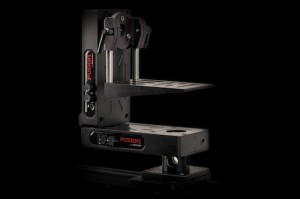 Accessories are a BIG part of NAB – it’s not just about the cameras… Here are a few of those tools that caught my eye and that I think are relevant to this blog’s readership.
Accessories are a BIG part of NAB – it’s not just about the cameras… Here are a few of those tools that caught my eye and that I think are relevant to this blog’s readership.
Pictured to the left is the Kessler Fusion. I wrote a post on this a few weeks before NAB when Kessler launched their site – but the full Fusion was display at NAB and it was attracting a ton of attention, not only because of it’s relatively inexpensive price (under $6,000.00 for the Fusion starter kit – a steal for a motion control system), but because of its ease of use. A connection to the Fusion brain is accessible via ethernet, USB, or WiFi (no internet required), and then the software is accessed through your HTML5 browser on any device. The software is intuitively laid out (and customizable!), and gives you the ability to keyframe moves and smooth the ease in and ease out of those moves via Bezier curves. It should be noted that the Fusion is also not just for time-lapse – it is fully functional for live action and stop-motion motion control shots as well, allowing you to play back your key framed moves exactly. The starter kit mentioned above comes with the Fusion brain and two modular bricks and included hardware for configuring them into a pan/tilt any number of JIB/slider moves you can think of. Of course, the modular design is expandable for up to 256 axes of movement (would love to see that). It can also be programmed to pull your Iris and focus when paired with the appropriate hardware – which is HUGE for me. It is compatible with all pre-existing Kessler sliders/dollies that This is an incredible piece of gear and technology, and I can’t wait to play with it more. I’ve seen it work fantastically with EF lenses for those that might be curious – and NAIL focus.
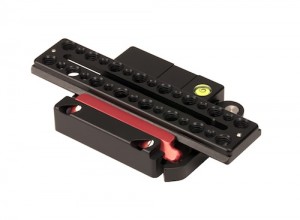 Kessler was also showing off its new Kwik Release System, which is a camera fastening system that instantly locks when the mounting plate is placed in the receiver, and can be quickly unlocked with a push-button release gate. A quick release plate is one of the most useful accessories you can spend your money on – I SWEAR by them. (No more screwing in tripods heads into your sliders, or trying to slide them into tripod heads.) By pre-mounting all of your support gear with receiver plates and placing a camera mount on the bottom of your camera, you can move between tripods, sliders, jibs, etc… with speed and ease. I have been using Really Right Stuff plates for the past couple years to do this and am very excited to hear that the new Kessler system will mate with the RRS plates that I already own.
Kessler was also showing off its new Kwik Release System, which is a camera fastening system that instantly locks when the mounting plate is placed in the receiver, and can be quickly unlocked with a push-button release gate. A quick release plate is one of the most useful accessories you can spend your money on – I SWEAR by them. (No more screwing in tripods heads into your sliders, or trying to slide them into tripod heads.) By pre-mounting all of your support gear with receiver plates and placing a camera mount on the bottom of your camera, you can move between tripods, sliders, jibs, etc… with speed and ease. I have been using Really Right Stuff plates for the past couple years to do this and am very excited to hear that the new Kessler system will mate with the RRS plates that I already own.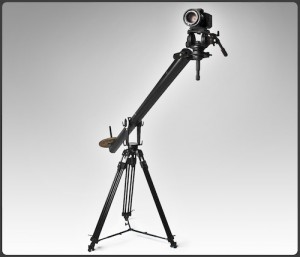 Cinevate was also showing off some support gear – namely their new Axis Jib – which is a quick and simple jib that comes straight out of the case and can be set up in a short amount of time. While there are many jibs out there that our built for speed and ease of use – this is one of the few jibs I have seen that is completely contained within a single tube – which means no pinch points for your fingers to get trapped in while you are rushing to set the jib up or operating it. The tube comes in two pieces that snap together with a small twist, and the back end of the jib contains an internal counterweight. This helps you set the jib up even quicker, as you can just put a rough amount of counter weight on the back and then fine tune it with the internal trim weight. The jib comes with a 100mm ball head that fits on to any pair of rugged sticks with a 100mm bowl. On top of the ball head is a riser, which Cinevate has cheese plated out so that you can attach arms with monitors for the operator as well as other accessories. On the hinge of the jib, they have also incorporated a dry erase ring (much like on a follow focus) so that you can mark your tilt points. The jib also has a 100mm bowl at the camera end and supports a payload of 50 lbs. The coolest part about the camera mounting end of the jib though is that it can be inverted or locked at 90 degrees which opens up a lot of possibilities for creative jib moves.
Cinevate was also showing off some support gear – namely their new Axis Jib – which is a quick and simple jib that comes straight out of the case and can be set up in a short amount of time. While there are many jibs out there that our built for speed and ease of use – this is one of the few jibs I have seen that is completely contained within a single tube – which means no pinch points for your fingers to get trapped in while you are rushing to set the jib up or operating it. The tube comes in two pieces that snap together with a small twist, and the back end of the jib contains an internal counterweight. This helps you set the jib up even quicker, as you can just put a rough amount of counter weight on the back and then fine tune it with the internal trim weight. The jib comes with a 100mm ball head that fits on to any pair of rugged sticks with a 100mm bowl. On top of the ball head is a riser, which Cinevate has cheese plated out so that you can attach arms with monitors for the operator as well as other accessories. On the hinge of the jib, they have also incorporated a dry erase ring (much like on a follow focus) so that you can mark your tilt points. The jib also has a 100mm bowl at the camera end and supports a payload of 50 lbs. The coolest part about the camera mounting end of the jib though is that it can be inverted or locked at 90 degrees which opens up a lot of possibilities for creative jib moves.

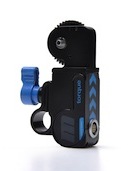
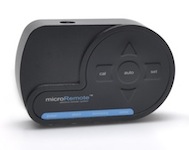
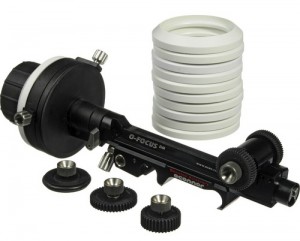 OConnor was also showing off their new studio follow focus intended to deal with the photo lens focus issues mentioned above. The O-Focus Photo Dual Mini features a hand wheel that allows you to set hard stops at close focus and infinity so you can work around focus rings that spin infinitely. The gearing from the wheel to the lens gear is also setup to give you 270 degrees of rotation for every 360 degrees that you spin the hand wheel. This gives your 1st AC (or the operator) a longer pull while moving the actual focus ring less – great for exact focus pulls. I suppose the hard stops could also be set to mark a focus pull from one subject to another. The inclusion of an on/off switch makes this a feasible application in case the focus puller needs to quickly improvise.
OConnor was also showing off their new studio follow focus intended to deal with the photo lens focus issues mentioned above. The O-Focus Photo Dual Mini features a hand wheel that allows you to set hard stops at close focus and infinity so you can work around focus rings that spin infinitely. The gearing from the wheel to the lens gear is also setup to give you 270 degrees of rotation for every 360 degrees that you spin the hand wheel. This gives your 1st AC (or the operator) a longer pull while moving the actual focus ring less – great for exact focus pulls. I suppose the hard stops could also be set to mark a focus pull from one subject to another. The inclusion of an on/off switch makes this a feasible application in case the focus puller needs to quickly improvise.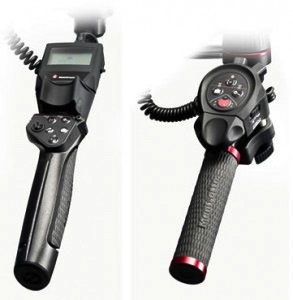 Manfrotto also showed off a new focus assist – an electronic remote that plugs directly into a Canon DSLR body to access its internal electronics and control focus. This removes the need for there to be any sort of external hardware that interfaces with the lens itself – and its always useful to have as little touching the camera as possible to insure steadiness – especially on DSLR’s where a slight bump can cause an aberration in the image due to the sensitive rolling shutter on these CMOS sensors. Manfrotto has released two versions of this remote – one that clamps on to the pan/tilt arm of a fluid head, and a deluxe version that is built to work on the hand grip of their new DSLR SYMPLA rig. Both remotes give you control over in and out focus points and focus speed, but because they interface with the Canon firmware directly – they can also control record start & stop, live view, one-touch auto-focus, digital zoom, aperture and exposure, ISO settings. However, the deluxe version also has an LCD that displays additional information such as battery levels, media space, and color temp. Basically the only thing these remotes can’t control is the zoom since it has to be adjusted manually on all EF lenses. Though if you paired this device with the Redrock microRemote finger wheel and attached the torque motor to a gear on the zoom ring rather than the focus ring, you could theoretically control focus on one hand grip of your shoulder rig and zoom on the other. At any rate, this accessory should prove incredibly useful for videographers and news shooters who have to operate, dial in settings, and pull focus on the fly. I haven’t had a chance to try this out extensively – but I think that these tools are going to be very welcome by DSLR shooters out there – especially since I know most people out there often don’t have the luxury of having a 1st AC with them to pull focus.
Manfrotto also showed off a new focus assist – an electronic remote that plugs directly into a Canon DSLR body to access its internal electronics and control focus. This removes the need for there to be any sort of external hardware that interfaces with the lens itself – and its always useful to have as little touching the camera as possible to insure steadiness – especially on DSLR’s where a slight bump can cause an aberration in the image due to the sensitive rolling shutter on these CMOS sensors. Manfrotto has released two versions of this remote – one that clamps on to the pan/tilt arm of a fluid head, and a deluxe version that is built to work on the hand grip of their new DSLR SYMPLA rig. Both remotes give you control over in and out focus points and focus speed, but because they interface with the Canon firmware directly – they can also control record start & stop, live view, one-touch auto-focus, digital zoom, aperture and exposure, ISO settings. However, the deluxe version also has an LCD that displays additional information such as battery levels, media space, and color temp. Basically the only thing these remotes can’t control is the zoom since it has to be adjusted manually on all EF lenses. Though if you paired this device with the Redrock microRemote finger wheel and attached the torque motor to a gear on the zoom ring rather than the focus ring, you could theoretically control focus on one hand grip of your shoulder rig and zoom on the other. At any rate, this accessory should prove incredibly useful for videographers and news shooters who have to operate, dial in settings, and pull focus on the fly. I haven’t had a chance to try this out extensively – but I think that these tools are going to be very welcome by DSLR shooters out there – especially since I know most people out there often don’t have the luxury of having a 1st AC with them to pull focus. 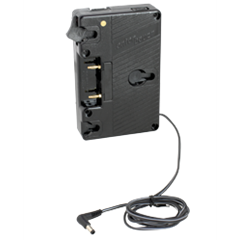 Of course all these accessories are great – but many of them require power. In order to keep your rig simple, its always nice to use an on-board, external battery to power both your camera and all of its auxiliary components. I have used Anton Bauers to do this for the past couple of years with my DSLR rigs. This year at NAB they announced a new battery mount (The QRC-CA940) that is specifically designed for use with the C300 and C500. What makes it unique is that this mount comes equipped with a DC connector that outputs the proper 7.2v current for powering the Cinema EOS cameras. It also has an additional (3) PowerTaps that output 14.4v for powering other accessories (typically the camera mounts only have one addition PowerTap). This accessory is fantastic for use with the Cinema EOS systems, but I foresee a huge market for this item in conjunction with the Black Magic Cinema Camera, as that camera does not have a removable battery and users will be in need of an external power source. However, currently the QRC-CA940 cannot support the BMCC as it requires an input voltage of 12-30v. But if they can work the voltage out and keep the same design, the BMCC is in need of a single power source that can power both the camera and multiple accessories. I wouldn’t be surprised to see this released down the road.
Of course all these accessories are great – but many of them require power. In order to keep your rig simple, its always nice to use an on-board, external battery to power both your camera and all of its auxiliary components. I have used Anton Bauers to do this for the past couple of years with my DSLR rigs. This year at NAB they announced a new battery mount (The QRC-CA940) that is specifically designed for use with the C300 and C500. What makes it unique is that this mount comes equipped with a DC connector that outputs the proper 7.2v current for powering the Cinema EOS cameras. It also has an additional (3) PowerTaps that output 14.4v for powering other accessories (typically the camera mounts only have one addition PowerTap). This accessory is fantastic for use with the Cinema EOS systems, but I foresee a huge market for this item in conjunction with the Black Magic Cinema Camera, as that camera does not have a removable battery and users will be in need of an external power source. However, currently the QRC-CA940 cannot support the BMCC as it requires an input voltage of 12-30v. But if they can work the voltage out and keep the same design, the BMCC is in need of a single power source that can power both the camera and multiple accessories. I wouldn’t be surprised to see this released down the road.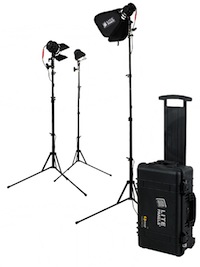 Last, but not least, I wanted to throw mention to LitePanels new 3-light Sola ENG set. And while lights are technically not accessories or support – this kit is too useful, lightweight, and mobile not to mention. As the name suggests it contains (3) of LitePanels recently introduced Sola ENG lights, which are daylight balanced LEDs with a fresnel lens that draw 30w of power and have an equivalent output of 250w. The kit also includes diffusion and CTO to warm diffuse and warm the lights, stands, barn doors, AC and DC power (for powering from the wall or battery), and a collapsable soft box to turn one of the lights into a larger, softer source. I have really enjoyed using these lights in the field – they provide nice quality light that is perfect for a small fill or kick. Some other DPs have also told me they really love these lights – they are perfect accent lights when mixed with natural lighting – and can also be used as a highly portable interview lighting kit. WIth the inclusion of the soft box, you can now turn one of the lights into a nice, soft key light – which makes this kit perfect for documentary filmmakers on-the-go who have to set up quick, impromptu interviews. The ability to power all of these lights off batteries also makes this kit ideal for setting up an interview almost anywhere – no more cords or generators needed… obviously: these are for indoor use or overcast days. They cannot fight the sun – you will still need the big boys and genies to do that.
Last, but not least, I wanted to throw mention to LitePanels new 3-light Sola ENG set. And while lights are technically not accessories or support – this kit is too useful, lightweight, and mobile not to mention. As the name suggests it contains (3) of LitePanels recently introduced Sola ENG lights, which are daylight balanced LEDs with a fresnel lens that draw 30w of power and have an equivalent output of 250w. The kit also includes diffusion and CTO to warm diffuse and warm the lights, stands, barn doors, AC and DC power (for powering from the wall or battery), and a collapsable soft box to turn one of the lights into a larger, softer source. I have really enjoyed using these lights in the field – they provide nice quality light that is perfect for a small fill or kick. Some other DPs have also told me they really love these lights – they are perfect accent lights when mixed with natural lighting – and can also be used as a highly portable interview lighting kit. WIth the inclusion of the soft box, you can now turn one of the lights into a nice, soft key light – which makes this kit perfect for documentary filmmakers on-the-go who have to set up quick, impromptu interviews. The ability to power all of these lights off batteries also makes this kit ideal for setting up an interview almost anywhere – no more cords or generators needed… obviously: these are for indoor use or overcast days. They cannot fight the sun – you will still need the big boys and genies to do that.













I just bought two of the Litepanel Sola ENG lights in the past week and a half. These were to add to my kit of three 1x1s and for a current job to use the Sola ENGs to light a small seamless.
All in all they worked very well. Color temp lines up with the 1x1s, light is very even and controllable, amount of light is just this side of enough when using them with the 1x1s.
Build quality is more akin to a speedlite than a strobe (in still terms.)
Couple of blog posts I did on them:
http://www.jonroemer.com/blog/2012/05/sola-eng/
http://www.jonroemer.com/blog/2012/05/sola-engs-on-set/
awesome post. Kessler makes the best stuff
Hi Vincent, I’d like to start building a kit to shoot shorts, music videos, and industrial videos. What camera would you suggest for this, and what gear and accessories should I purchase first? I’m willing to grow the kit over the next six months, making purchases gradually. I’ll obviously use rentals for big shoots but I’d like to own the core of the kit so I can tinker and experiment as much as possible. Sorry if you’ve already answered questions like this before. If that’s the case, could someone point me in the right direction. Cheers.
Vincent Laforet Reply:
May 19th, 2012 at 11:19 am
Have you checked out the gear section of this blog?
That’s the coolest thing I’ve ever seen so far!
Does anyone know where to buy one in Canada?
The Anton Battery plate will work fine with the BMCC, you just can’t use the supplied cable. A standard d-tap cable attached to one of the plate’s plugs will work fine, as its 14.4v is within the 12v-30v range of the camera.